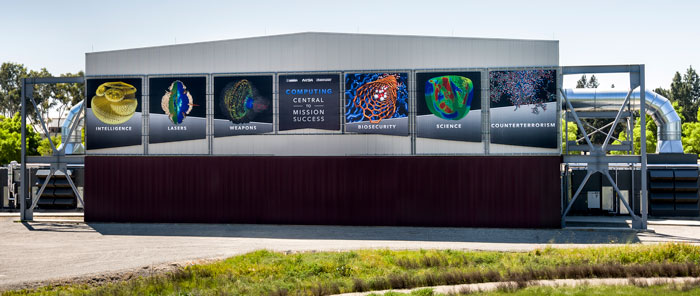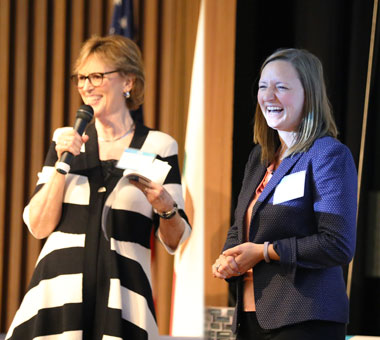Positioning the Laboratory for continuing excellence in science and technology directed at important national missions
In FY 2017, the Laboratory engaged sponsors and stakeholders, provided technical leadership in key mission areas, and strengthened the foundation for future successes.
Strategic Engagements and Initiatives
Laboratory Director William Goldstein and his management team engaged in discussions about national security and the evolving strategic landscape with wide-ranging audiences. Livermore welcomed many visitors from DOE and NNSA headquarters, Congress, and the executive branch (including unified combatant commands), as well as work sponsors. Notably, LLNL conducted workshops and tabletop exercises on multi-domain deterrence in 2016 and 2017 and co-hosted with the U.S. Air Force a meeting on the subject in Washington, D.C. In addition, Lawrence Livermore, Los Alamos, and Sandia national laboratories prepared joint background papers providing technical perspectives on issues pertaining to nuclear force posture.
As described elsewhere in this Annual Report, Livermore is providing technical leadership in many areas of its national security mission. Examples include the W80-4 life-extension program, the advancement and application of high-performance computing, key nuclear threat reduction initiatives, NNSA complex modernization, and technical areas such as additive manufacturing and petawatt laser development.
New Facilities and Modernized Infrastructure
Construction of LLNL’s Advanced Manufacturing Laboratory (AML) is nearly completed. Sited at a public-access location, this 13,700 square-foot facility will house cutting-edge manufacturing research capabilities for use by Livermore employees working with industry and academic partners. Many other projects are in preparation or under way as part of a $150 million facility construction/acquisition portfolio that the Laboratory is executing. These include the $31 million Expand Electrical Distribution project, a new $32 million Emergency Operations Center, and a $90 million Exascale Computing Facility Modernization project, which are at various stages of Critical Decision approval. In addition, some 30 general plant projects are ongoing.
The effective facility and infrastructure (F&I) investment planning tools developed and used by Livermore are benefiting revitalization of the LLNL campus. They are also helping NNSA institute an enterprise-wide Master Asset Plan (MAP) to align infrastructure investments with mission goals and reduce risks to mission success. LLNL is working as an innovative partner with NNSA’s Office of Safety, Infrastructure, and Operations (NA-50) to develop the methodologies, templates, and tools for MAP. In addition, LLNL pioneered the “Deep Dive” meeting process with NNSA in 2016. With NNSA’s improved F&I management process now in its second year, Livermore continues to lead the way and set a high standard of success for other NNSA sites.
Sustaining Workforce Excellence
An outstanding workforce is the Laboratory’s principal strength. Staff members bring to their jobs impactful new ideas, work with integrity and zeal, and thrive in an inclusive work environment. LLNL was named to Reuter’s list of Top 25 Global Innovators—Government, which identifies and ranks the publicly funded institutions doing the most to advance science and technology. The Laboratory’s many accomplishments highlight staff quality and the importance of recruiting and nurturing future programmatic and technical leaders. Notably, two Laboratory employees were among the 100 recipients of the prestigious Presidential Early Career Awards for Scientists and Engineers (see Workforce Recognition ).
Leadership development is crucial to LLNL’s future. During FY 2017, Skillsoft and Elearning! presented Livermore top honors for implementing a comprehensive leadership development training program designed to grow leaders at all levels of the organization. The Laboratory’s program includes online resources and courses, coaching opportunities, and instructor-led workshops. Other special opportunities for building skills include Research Slam! for postdoctoral fellows. They are offered coaching help and invited to compete in giving the best three-minute presentation answering the question, “Why is your research important?” In addition, 15 LLNL scientists and engineers were honored in the annual Early and Mid-Career Recognition Program. Winners received cash awards and some institutional funding to pursue research activities in their areas of interest.
LLNS Board of Governors Activities
The LLNS Board of Governors and its committees provide oversight to the Laboratory and delve into issues crucial to mission and mission-support activities. External review committees (ERCs), panels of independent experts including Board members, held six meetings in FY 2017 to critically assess the quality of LLNL’s technical workforce and the effectiveness of research efforts in meeting mission goals and future national needs. Their reports, which provided DOE/NNSA with an independent validation of work quality, consistently affirmed the mission relevance and high impact of Laboratory research. Functional Management Reviews (FMRs) chartered by the Board examined issues on an as-needed basis. Seven FMRs were completed in FY 2017 in topical areas ranging from computerized maintenance management to work planning and control. Recommendations provided by Board committees, ERCs, and FMRs have led to substantive responsive actions.







